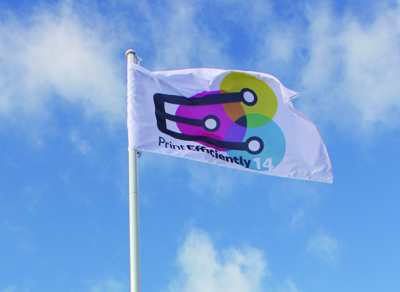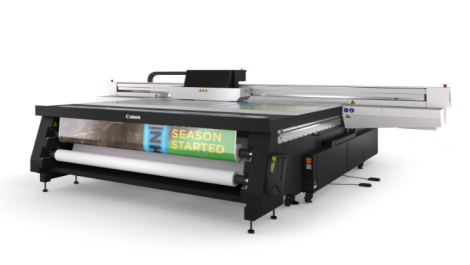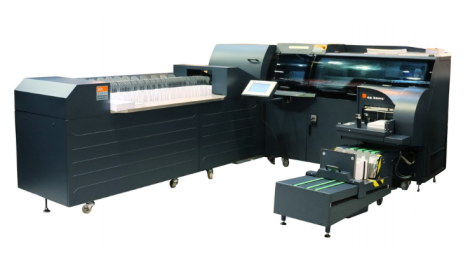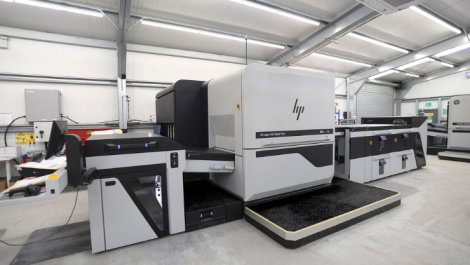It ran over six days in October at Apex Digital Graphics in Hemel Hempstead, featuring more than 15 partners and more than 40 machines. Digital Printer worked the rooms at Print Efficiently to find out what people were talking about.
It was possible at Print Efficiently to follow the trail of an individual job, from order via web to print right through to post-press and even mailing, with the presence of the KAS Mailmaster 465HS envelope inserting system at the event. Personalised show guides were being produced, as were calendars (to show off different bindings) and wall planners.
This ‘networked print room’ is a concept that most printers are familiar with, and many are at least part of the way towards having their own. Many visitors therefore come to meet specific vendors and discuss their requirements, rather than following the complete, integrated workflow. Digital Printer, however, used its time at the event to follow that path, and to talk to exhibitors about the questions that were being asked by visitors, and what the answers were.
We started, as is proper, at the front end with web to print (Vpress) and MIS (Shuttleworth). In the absence that day of the always-loquacious Tim Cox, George Terry from Vpress customer support stood in, explaining that integration was the big topic of conversation. Customers, he said, want a web to print that communicates jobs directly to MIS, sending a PDF bearing optical marks that when passed through to workflow hot folders can be used to automatically set up printing and finishing equipment.
‘The less touches from A to B there are, the more efficient you can be,’ he said. Vpress, he added, always wants to integrate with fellow vendors.
One such integration has been with Shuttleworth, whose Dawn Safford said that jobs were being imposed and paired with JDF tickets, before going to one of two prepress systems: Screen’s Equios and Fuji XMF. ‘Our system is capable of integrating with multiple web to print and prepress solutions and it’s something that customers need to look at if they are buying either an MIS or web to print. They should buy something with existing connections.’
Printing digitally
The next step was into the digital printing room, where Colourbyte was displaying Epson wide format devices, and Apex Digital Graphics had a Konica Minolta bizhub 1060 running. But wait! Before that, a quick chat with the paper guy, John Parker from Premier Paper, who said that the merchant is constantly adding to its wide range of papers for all digital printing technologies. ‘Digital printers now expect to see the whole range of papers for digital that offset printers use on a day to day basis,’ said Mr Parker. ‘We are looking to mirror our offset offering, and at some stage in the near future we will do that.’
Colourbyte director Tim Stockley revealed that about 50% of its conversations at Print Efficiently had been about proofing, and 50% about wide format production. Increasingly though, it was apparent that commercial printers were looking to wide format applications for business expansion. The big Epson on display was the eight colour, 64-inch wide SureColor S70600, expandable to ten colours with metallic and white. It is a solvent machine, capable of outdoor and indoor applications. ‘People are quite surprised at the quality of a solvent machine like this,’ he told Digital Printer. ‘We’ve had customers saying the quality of this machine is as good as Latex. We are from a high end proofing background so we are trying to get as much as possible out of these machines, to show how good they really are.’
Colourbyte was also showing its TuffJet range of media, which includes a polyester canvas with a solvent receptive coating to repel water, gloss backlit films, crystal clear films, and digital wallpapers, as well as the matte scrim banner and gloss vinyl self-adhesive media that is ‘bread and butter’ for solvent.
Apex Digital Graphics digital sales manager Mike Ryan was poised by the Konica Minolta press, ready to talk about the manufacturer’s latest generation of machines, in which the 110 A4 pages per minute bizhub 1100 is the flagship. The 1060 on display is a mid-range press in comparison. Customers get options for feeding paper into the machine, such as a single high capacity feeder, a friction-fed dual feeding tray, or a suction-fed 3-tray drawer.
‘It’s a real bonus to the commercial printer that might not have the budget to get the high speed machines but does not want to compromise on feeding,’ said Mr Ryan.
New on these machines is a fuser with a thicker diameter roller, which keeps more heat, making fusing more consistent. ‘The fuser is the key to success in these machines,’ he added.
Since Apex’s heritage is in the offset world, frequent questions asked of it are whether it can match digital output to offset, whether it can hit ISO standards with digital, and whether the Konica Minolta takes offset stocks. Generally, the answer to all of those is yes. ‘With colour standards, what Apex brings to the party is added value: our knowledge and ability to give offset customers the ability to use the digital press as a complement to their offset press. If that means doing some colour management and measuring, we can deliver that comfortably,’ he said.
To do so it is increasingly using Kenilworth-based TSS Technology and the Bodoni PressSign software, and it is ‘aiming people at ISO without huge cost’ said Mr Ryan.
End of the line
And so to finishing, where Bryan Godwin of IFS smilingly reflected on a successful Print Efficiently, and observed that ‘some confidence is coming back into the industry’. ‘Numbers are way up on last year. That’s a great sign for the economy and for us that we are getting it right,’ he said.
The star of IFS’s show in terms of interest was the Horizon die-cutter, the RD-4055, which is the manufacturer’s first foray into die-cutting. ‘The reaction has been incredible. It’s a new market that people can get into, and it’s half the price of the expensive machines out there. All printers are looking for something they can be a bit unique in. It has a lot of unique features, such as easy changing of the metal die – much faster than a traditional cylinder operation – automation, touch screen control. This system, fully loaded, costs about £70,000. That’s sending people away thinking about something that they always thought was too expensive before.’
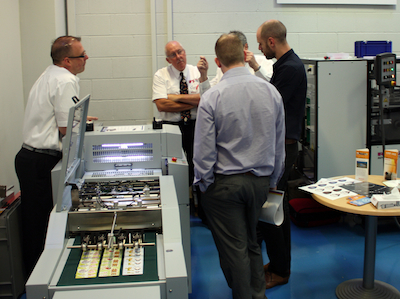
There was great interest in the Horizon RD-4055 die-cutter at the event
Renz and PDC were nearby, showcasing a range of binding solutions, large and small. Ian Bullock of Renz said it was that time of year when everyone questioned the speed of their calendar binding. The company’s Mobi systems are popular in the market and extend to B2 format now. Renz is waiting for a call…
‘From our point of view, in the next year one of the UK companies with a big Indigo will start to do A2 calendars. We are ready for them to start producing for that market.’
Up past the Ryobi 755G litho press with LED-UV curing (one of which was sold on Day 1 of Print Efficiently – the technology is the ‘death of B2 digital’ joked Apex Digital Graphics’ Neil Handforth; at least, we think he was joking…), was KAS Paper Systems’ Steve Jarvis, standing by the Mailmaster 465HS envelope inserting system. ‘For us, the reason for being here is to meet printers. They have brought in repro and finishing and they’re still not doing particularly well. We’ve had three printers talk to us today about bringing mailing and fulfilment in-house,’ he said.
‘If they have got the space and can justify it in terms of the cost of what they are sending out or doing by hand, our cheapest machine is £800 per month over five years.’
